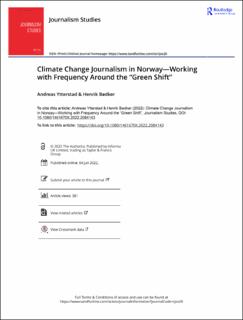Climate Change Journalism in Norway—Working with Frequency Around the “Green Shift”
| dc.contributor.author | Ytterstad, Andreas | |
| dc.contributor.author | Bødker, Henrik | |
| dc.coverage.spatial | Norway | en_US |
| dc.date.accessioned | 2022-08-05T12:50:42Z | |
| dc.date.available | 2022-08-05T12:50:42Z | |
| dc.date.created | 2022-06-29T10:50:41Z | |
| dc.date.issued | 2022-06-04 | |
| dc.identifier.issn | 1461-670X | |
| dc.identifier.issn | 1469-9699 | |
| dc.identifier.uri | https://hdl.handle.net/11250/3010383 | |
| dc.description.abstract | This article traces the origins of the term of the green shift, which gained increased cultural, social and political traction in Norway after it was introduced in 2015 by journalist Anders Bjartnes, editor of Energi og klima (2011-). By looking at this outlet as well as two other contemporary niche media, Harvest (2013-) and Naturpress (2016-), we show how this term provided a way of working with frequency, one of the 12 news values outlined in Galtung and Ruge’s seminal study from 1965. Inspired by discourse-historical analysis, we base our article on interviews with the editors of the three outlets, their journalistic output as well as on contextual material in order to show how the slow, uneven, global and partially invisible process of climate change was given a different temporal frame through the notion of the green shift. By addressing notions of frequency in relation to a specific time and context, we speak, on the one hand, to discussions about how an event-driven journalism struggles with the complex temporalities of climate change and, on the other, to recurrent calls for providing a more “context-driven reflection on the value and legacy of Galtung and Ruge” [Joye, Stijn, Ansgard Heinrich, and Romy Wöhler. 2016. “50 Years of Galtung and Ruge: Reflections on Their Model of News Values and its Relevance for the Study of Journalism and Communication Today.” CM Komunikacija i Mmediji 36: 5–28]. | en_US |
| dc.description.sponsorship | This work was supported by Norges forskningsråd: [Grant Number 283345]. | en_US |
| dc.language.iso | eng | en_US |
| dc.publisher | Routledge | en_US |
| dc.relation.ispartofseries | Journalism Studies; | |
| dc.rights | Attribution-NonCommercial-NoDerivatives 4.0 Internasjonal | * |
| dc.rights.uri | http://creativecommons.org/licenses/by-nc-nd/4.0/deed.no | * |
| dc.subject | Climate changes | en_US |
| dc.subject | Niche medias | en_US |
| dc.subject | News events | en_US |
| dc.subject | Frequency | en_US |
| dc.subject | Temporality | en_US |
| dc.subject | Journalistic norms | en_US |
| dc.title | Climate Change Journalism in Norway—Working with Frequency Around the “Green Shift” | en_US |
| dc.type | Peer reviewed | en_US |
| dc.type | Journal article | en_US |
| dc.description.version | publishedVersion | en_US |
| dc.rights.holder | © 2022 The Author(s) | en_US |
| cristin.ispublished | true | |
| cristin.fulltext | original | |
| cristin.qualitycode | 2 | |
| dc.identifier.doi | https://doi.org/10.1080/1461670X.2022.2084143 | |
| dc.identifier.cristin | 2036000 | |
| dc.source.journal | Journalism Studies | en_US |
| dc.source.pagenumber | 1-17 | en_US |
| dc.relation.project | Norges forskningsråd: 283345 | en_US |
Tilhørende fil(er)
Denne innførselen finnes i følgende samling(er)
-
Publikasjoner fra Cristin [3362]
-
SAM - Institutt for journalistikk og mediefag [338]
SAM - Department of Journalism and Media Studies

